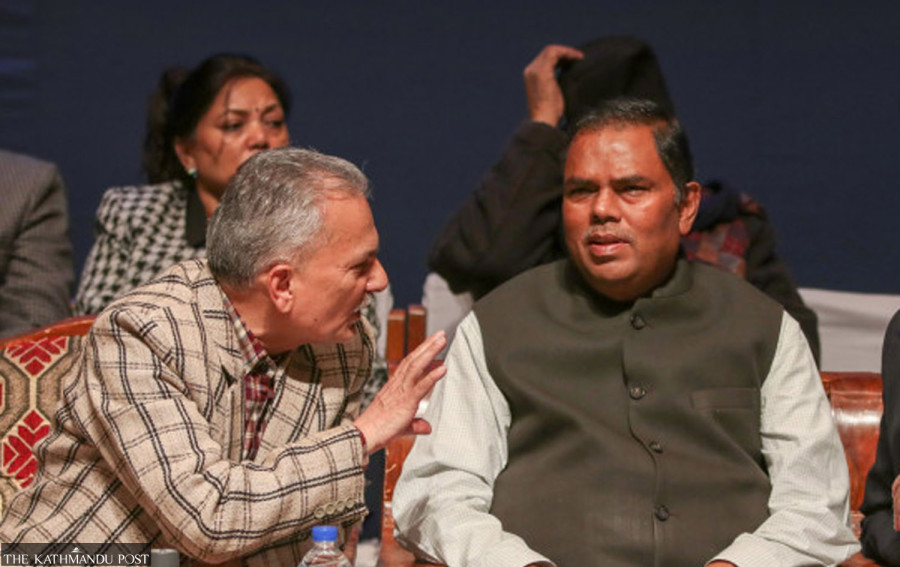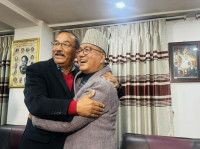Politics
Bhattarai, Yadav set to part ways 3 years after union as discord reaches tipping point
Two leaders, who are like chalk and cheese, have partnered longer than many expected, and a split is not if but when.
Tika R Pradhan
Baburam Bhattrarai and Upendra Yadav were fundamentally different—they were like chalk and cheese. But three years ago in May, they came up with a decision to merge their parties, after a failed attempt some two years before. They thought they could manage to get along.
Bhattarai was leading the Naya Shakti Party Nepal, which was just three years old. Yadav, who had led various parties with different names, was the chair of the Sanghiya Samajbadi Forum-Nepal.
They announced Samajbadi Party Nepal. Their goal: building a national level political force that could become an alternative to traditional communist parties and the Nepali Congress. The attempt has failed.
A divorce between Bhattarai, the federal council chair of the party, and Yadav, the central chair, is not a matter of if but when, with the former already conveying a message that the two should part ways amicably so as to avoid public mud-slinging.
“With Yadav calling a meeting of the central committee without consulting other leaders, I don’t think the party will have the same old central committee now,” said a leader close to Bhattarai. “We will have our own central committee meeting.”
The current Janata Samajbadi Party was formed in April 2020 after the Bhattarai-Yadav-led Samajbadi Party Nepal merged with the Rastriya Janata Party. It, however, split in August last year. The Janata Samajbadi Party was awarded to Yadav and Bhattarai by the Election Commission, following which Mahantha Thakur formed the Loktantrik Samajbadi Party.
Insiders say it may take some time before the Janata Samajbadi split is announced.
A central executive committee member close to Bhattarai said that a meeting of the leaders of their faction has come to a conclusion that they should continue their “struggle”against Yadav and wait and see for a few days.
“Yadav has been using various tactics to garner support of the leaders saying that Bhattarai is going to walk out of the party anyway,” said the member, who wished to remain anonymous saying the party is at a critical juncture.
Given the lack of compatibility between the two leaders, the merger in May 2019 was never organic, something even the party insiders from both the factions do not hesitate to share in private. According to them, the situation at that time had necessitated the union. Struggling to run the party, Bhattarai needed a piggyback ride. Yadav assumed he could use Bhattarai as a face to transform his party, considered regional or “Madhes-based,” into a national political force.
Since Yadav has led parties under various names, he has his own working style and decision-making, a source of discomfort for Bhattarai. Although the Janata Samajbadi had instituted a three-member party headquarters comprising Yadav, Bhattarai and senior leader Ashok Rai just before the local elections, the party chair continued to have his own way, insiders say.
Lately, Bhattarai had been aiming to secure a majority in the Parliamentary Party (19 members) and central committee (503 members).
Prior to the May 13 local polls, insiders say, Bhattarai had managed to have a significant chunk of the 19 lawmakers on his side as they were dissatisfied with the way Yadav was governing the party. But local polls were a disaster for the party, and it failed in the hill districts. Bhattarai gradually started to lose his grip on the party leaders.
A clever politician, Yadav then saw an opportunity to woo the dissidents. The CPN (Unified Socialist) had just changed its set of ministers in the Deuba government. Yadav called an informal meeting of the central executive committee, without inviting the Bhattarai faction, and decided to change its four ministers.
Those who were siding with Bhattarai were quick to desert him as joining the Yadav camp carried better prospects—with rewards of ministerial berths.
As soon as Bhattarai on Wednesday proposed to Yadav that they should part ways, the latter was quick to call a meeting of the Parliamentary Party. Yadav asked the lawmakers to pick sides.
“Yadav had informed us on Wednesday that Bhattarai could not adjust himself in the party, therefore those who came from the Naya Shakti Party are preparing to walk away,” said Mrigendra Singh Yadav, a leader close to Yadav who is also a National Assembly member.
On Thursday, Yadav decided to call a meeting of the party’s central committee meeting in Birgunj on July 11-12.
Leaders close to Yadav say after maintaining silence for quite a long time, Bhattarai suddenly invited the party chair and proposed the idea that they should not remain under the same roof. Yadav did not bother to disabuse Bhattarai.
“Now with both Bhattarai and Yadav agreeing to part ways, I don’t think the Bhattarai faction will join the Birgunj central committee meeting,” said Mahesh Chaurasia, Yadav’s press coordinator. “The Bhattarai faction may either wait until the central committee meeting or organise a separate gathering prior to that—depending on their strategy. Our party split, however, is inevitable.”
He said senior leader Ashok Rai, who had left the CPN-UML to form his own party and later joined Yadav while forming Sanghiya Samajbadi Forum, and leaders close to him are not in favour of splitting the party. Therefore, they will remain within the party.
“Since Yadav commands a majority, he is in a comfortable position,” said Chaurasia. “It’s up to the Bhattarai faction to make the next move.”
Bhattarai’s political base also looks comparatively weak.
He was the only one to have made it to the House of Representatives from Naya Shakti from the 2017 elections. He had formed Naya Shakti in 2016, about a year after severing ties with the Maoist party, days after the constitution was promulgated. He argued that the country needed a “new force”—hence the party name accordingly—for the “socioeconomic transformation of the country”.
From Naya Shakti, two people were elected Provincial Assembly members in Gandaki and one in Bagmati. Prem Tamang, who was elected to the Bagmati Provincial Assembly, has already defected to the Nepali Congress.
Of the four Janata Samajbadi ministers, Mahendra Rai Yadav was the only one who came from the former Rastriya Janata Party supporting Bhattarai. But now amid new developments, Mahendra Rai Yadav as well as lawmakers Amrita Agrahari and Rajkishor Yadav, who also came from then Rastriya Janata Party, have not taken sides, insisting that the party must not split.
“We are against the way the chairman has been treating us but that does not mean that the party should split,” Rajkishor Yadav told the Post. “We are not much aware of the recent events.”
According to him, there are around 10 members in the 33-member central executive committee representing the former Rastriya Janata Party and they will take necessary decisions after assessing the situation.
As of the development so far, Yadav appears in a comfortable position to retain the Janata Samajbadi. There is no clarity on what Bhattarai, who has for long lobbied for the formation of what he calls a “socialist centre,” plans to do.
A key architect of the Maoist “people's war,” Bhattarai served as finance minister from August 2008 to May 2009 and prime minister from August 2011 to March 2013.
Analysts say Bhattarai’s political career now hangs in the balance. He may choose to return to the Maoist party, but he has an aversion to both the “communist” and “Maoist” tags as he believes their relevance is over now.
Only recently, CPN (Maoist Centre) chair Pushpa Kamal Dahal and Bhattarai had held a meeting at the residence of Vice President Nanda Bahadur Pun. Leaders from both sides had told the Post that discussions revolved around exploring the possibility of creating a political outfit by bringing former Maoists under one roof.
On Thursday also, the two met at Pun’s residence.
“Dahal and Bhattarai held a meeting for around an hour today,” said Suk Bahadur Roka, chief personal secretary to Vice President Pun. “We don’t know what exactly transpired in the meeting though.”
Political analysts who have closely followed Yadav’s politics over the years had prophesied the future of the merger between Naya Shakti Nepal and Sanghiya Samajbadi Forum-Nepal.
CK Lal, a commentator who is also a columnist for the Post, said three years ago that the merger would not last long.
“Their union actually lasted longer than I had expected, and it was largely because the Rastriya Janata Party joined in,” Lal told the Post on Thursday. “Basically the problem is with the Marxist-Leninist schooling of Yadav and Bhattarai which says there either is the chief or the cadre. There is no second man in between.”
He offered more examples—Dahal versus KP Oli, Oli versus Madhav Nepal, Dahal versus Bhattarai, Yadav versus Mahantha Thakur and Man Mohan Adhikari versus Pushpa Lal Shrestha.
Building compatibility between Yadav and Bhattarai had already been a tough task, as the former considers himself the messiah of Madhes and the only person who can fight for the Madhes’ cause and the latter believes he only can lead an outfit that can bring about the change the country needs.
Despite his social capital and name as a public intellectual, Bhattarai’s acceptance among the leaders, especially those representing Madhes, was always low. Yadav, however, appears to know every trick in the political book.
Asked about the promise Yadav and Bhattarai had made of creating a “strong alternative force,” Lal said that was floated just for public consumption.
“Chances of an alternative force are slim,” he said.




 12.12°C Kathmandu
12.12°C Kathmandu















